2. 中国科学院水利部成都山地灾害与环境研究所山地表生过程与生态调控重点实验室, 成都 610041;
3. 云南省农业科学院农业环境资源研究所, 昆明 650201
2. Key Laboratory of Mountain Surface Processes and Ecological Regulation, Chinese Academy of Sciences, Institute of Mountain Hazards and Environment, Chinese Academy of Sciences and Ministry of Water Resources, Chengdu 610041, China;
3. Agricultural Environment Resources Institute, Yunnan Academy of Agricultural Sciences, Kunming 650201, China
近几十年来, 地下水硝酸盐污染已成为世界性问题, 不仅威胁着饮用水安全、农田灌溉和工矿用水[1, 2], 还加剧了以浅层地下水为补给的河流和湖泊等地表水的富营养化进程[3], 造成了区域性水资源短缺.特别是, 高度集约化农区土壤氮(N)素流失造成的地下水氮污染日益严重, 全国大部分区域的地下水NO3--N浓度已超过《地下水质量标准》(GB/T 14848)Ⅲ类水质要求, 其中, 约50%的浅层地下水监测点NO3--N浓度超过饮用水标准(20 mg ·L-1), 约40%左右的深层地下水监测点NO3--N浓度超过饮用水标准[4].而且地下水是干旱半干旱区域饮用水重要的来源之一, 作为饮用水NO3--N的最高可接受浓度: 中国为20 mg ·L-1, 欧盟为11.3 mg ·L-1, 美国为10 mg ·L-1, 地下水NO3--N污染不仅影响地下水生态环境安全, 还危害人畜生命健康[5~7], 造成了高铁血红蛋白血症[8]、人类胃癌[9]和动物硝酸盐中毒[10]等健康问题.因此, 了解浅层地下水中氮素时空分布及影响因素是保护地下水质量安全和可持续利用地下水资源的前提.
国内外学者对地下水中氮素时空分布及驱动因素进行了研究, 不同时空监测尺度下浅层地下水中氮浓度具有显著的时空变异, 且相关性良好[11], 一般来说, 农田区域浅层地下水中NO3--N浓度远高于居民区; 雨季浅层地下水中NO3--N浓度高于旱季, 而NH4+-N浓度小于旱季[12].浅层地下水中氮的时空分布受土地利用类型、施肥情况、水文过程、含水层特性和季节变化(降水或灌溉)等因素的影响[13].土地利用类型影响着地表氮的投入负荷, 进而影响着地下水氮浓度[14], 当土地利用类型相同时, 地下水中氮浓度与氮肥用量呈显著正相关[15].水文过程, 如: 土壤水渗流、地下水迁移和地表水及地下水补排等也会导致浅层地下水中氮呈现复杂的可变性[16], 还会改变浅层地下水化学环境, 进而影响氮浓度的变化[12].包气带土壤水文特征控制了表层土壤氮素淋溶到地下水中的负荷[17], 含水层特性也影响着浅层地下水中不同形态氮浓度的迁移转化[18, 19].季节变化引起降雨量的改变, 从而改变了地下水埋深, 随着地下水埋深的增加, 地下水NO3--N浓度呈下降趋势[20], 而水位上升时, 地表水中的氮不仅可以迅速渗入浅层地下水中[21], 而且地下水与高累积氮素土层的相互作用, 也会增加累积在土壤中氮素的溶出, 增加地下水氮浓度[22].高的降雨、灌溉和施氮量的叠加效应也增加了土壤氮淋溶至浅层地下水中, 增加地下水的氮污染风险[23].可见, 区域尺度下自然条件和人为活动等因素的复杂性和变异性, 也造成地下水中氮素的时空差异较大.
目前, 我国关于地下水中氮污染时空分布及影响因素的研究主要集中在华北平原、东北平原和宁夏平原黄灌区, 特别是华北平原地下水水位深, 季节性波动较小, 同时波动幅度受当地气象、水文及地质条件、生态补水和人工开采的影响[24], 但很少有研究关注高原湖泊周围区域浅层地下水氮污染的时空分布及驱动因素.由于各地区气候类型和水文地质环境的巨大差异, 使得高原湖泊流域地下水表现出水位浅和波动大等独特的水文特征[25].特别是高原湖泊周围盆地因地形平坦、交通便利, 是湖泊流域城镇和村落聚集区; 土壤肥沃, 水源充足, 是重要的种植业生产基地; 农业集约化程度高, 复种指数大, 是云南省高强度施肥、灌溉集中分布区, 地表氮投入负荷和水文条件等因素的叠加效应显著影响着高原湖泊周围浅层地下水质量, 使得高原湖泊流域浅层地下水氮污染最为严重.因此, 本研究通过对云南8个高原湖泊(滇池、洱海、抚仙湖、杞麓湖、异龙湖、星云湖、阳宗海和程海)周围区域在雨季(8、9月)和旱季(4、5月)进行浅层地下水和土壤剖面调查取样, 分析云南高原湖泊周围区域浅层地下水中各形态N浓度、组成比例和时空分布特征, 探讨影响高原湖泊周围区域浅层地下水中氮污染的主要驱动因素, 以期为评价云南高原湖泊周围区域浅层地下水中氮污染现状和防控浅层地下水氮污染提供科学依据.
1 材料与方法 1.1 研究区概况选取的滇池、洱海、抚仙湖、杞麓湖、异龙湖、星云湖、阳宗海和程海这8个高原湖泊分布在云南省的滇中、滇南、滇西和滇西北(图 1), 位于97°31′~106°11′E, 21°08′~29°15′N, 该区属低纬高原区域. 8个高原湖泊中的滇池和程海属长江水系, 抚仙湖、杞麓湖、异龙湖、星云湖和阳宗海属珠江水系, 洱海属澜沧江-湄公河水系.8个高原湖泊流域气候类型为亚热带低纬高原季风气候, 立体气候特点显著, 年温差小且日温差大, 年均温16.7℃; 降水充沛、分布不均且干湿季节分明, 年均降雨量为932 mm(表 1), 降水量最多的月份集中在6~10月, 约占全年降水量的80%以上.8个高原湖泊周围盆地主要是农田、村落和城镇分布, 社会经济发达, 人口稠密, 高原湖盆区域人口占流域总人口的80%以上.盆地土壤类型主要是水稻土、红壤、黄壤和紫色土, 成土母质多为河湖相沉积物和第四纪风化物.河湖相沉积物形成的土层结构因细砂、砾石的分布孔隙性大, 透水性强, 第四纪风化物形成的土层结构土壤黏重紧实, 透水性弱.盆地农田种植作物种类繁多, 主要包括水稻、玉米、豆类、薯类、烤烟、油菜、蔬菜和花卉等作物, 其中蔬菜和花卉等高耗型作物在高原湖泊流域盆地种植面积大, 复种指数高, 特别是滇池、杞麓湖、星云湖、异龙湖和洱海等都有大面积的集约化蔬菜和花卉种植, 其播种面积占流域总播种面积的40%以上, 造成了高原湖泊流域作物化肥施用量高. 2017年, 高原湖泊流域化肥氮施用量为165~405 kg ·hm-2, 平均施用量为283 kg ·hm-2, 化肥P2O5施用量为60~135 kg ·hm-2, 平均施用量为96 kg ·hm-2, 有机肥施用量为150~18 270 kg ·hm-2, 平均施用量为5 432 kg ·hm-2, 高原湖泊流域的施肥量远高于云南省其它区域, 是云南省其它区域施肥量的1.5倍左右[26].高强度的施肥和灌溉, 造成了农田土壤氮含量高, 土壤剖面中氮素累积量大, 在集中降雨和地下水位浅且波幅大等水文过程驱动下土壤氮素淋失对地下水中氮污染风险增加.
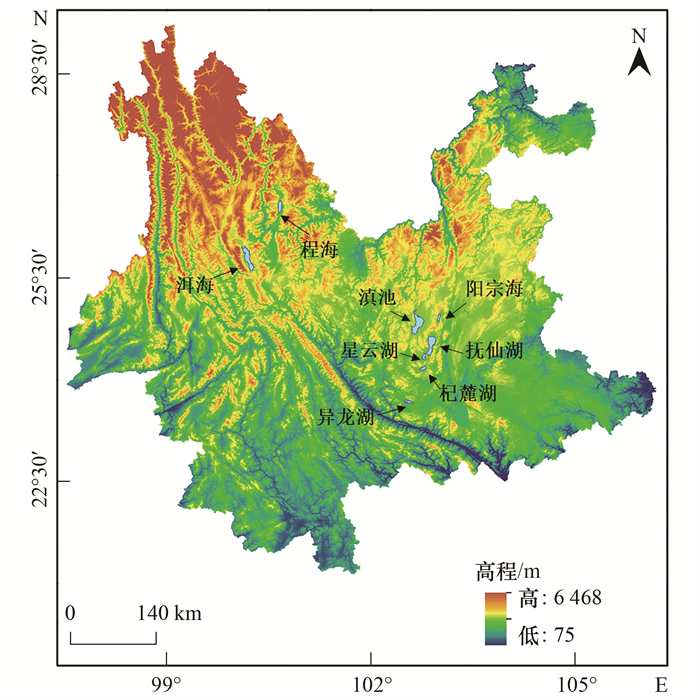
|
图 1 研究区位置示意 Fig. 1 Location of the study area |
|
|
表 1 云南8个高原湖泊流域区位特征 Table 1 Location characteristics of eight plateau lake watersheds in Yunnan province |
1.2 样品采集与分析
2020~2021年的旱季(4、5月)和雨季(8、9月), 对云南8个高原湖泊周围区域浅层地下水及土壤剖面进行监测和取样, 分别于雨季和旱季从8个高原湖泊周围居民区的饮用井和农田的灌溉井共采集浅层地下水水样463个, 其中, 异龙湖46个、程海38个、星云湖52个、抚仙湖54个、阳宗海46个、杞麓湖52个、滇池76个和洱海99个.用专用的水样采集器在距水面50 cm左右的深度采集水样, 样品被收集在聚乙烯瓶中, 放在有冰袋的保温箱中带回实验室, 并储存在4℃的冰箱中, 每个湖泊的水样在1周内完成分析测试.现场使用手持式多参数水质测量仪YSI(YSI Incorporated, USA)测量温度(T)、电导率(EC)、酸碱度(pH)、氧化还原电位(ORP)和溶解氧(DO).浅层地下水深(SWL, 水面至地表的高度)采用一根测量绳和钢卷尺进行测量.用Bran+Luebbe AA3型连续流动分析仪分析水样中NO3--N和NH4+-N浓度.用碱性过硫酸钾-紫外分光光度法测定总氮(TN)浓度.有机氮(ON)为TN减去NO3--N和NH4+-N.
每个高原湖泊选择典型的土壤类型和作物种植类型, 用100 cm高的螺旋土钻采集土壤剖面, 土壤取0~90 cm剖面样, 以0~30、30~60和60~90 cm分层取样, 共采集87个土壤剖面点位的261个样品, 其中, 滇池51个、抚仙湖36个、星云湖33个、杞麓湖27个、艺龙湖30个、阳宗海27个、程海18个和洱海39个.采集的土样装入聚乙烯密封袋中, 放在有冰袋的保温箱中带回实验室, 并储存在4℃的冰箱中, 用于测定土壤全氮(TN)、NO3--N、NH4+-N、pH、含水率(MWCs)和土壤有机碳(OCs)等指标.土壤NH4+-N和NO3--N用0.01mol ·L-1氯化钙(CaCl2)溶液提取后用连续流动分析仪测量, 土壤TN用碱性过硫酸钾消解-紫外分光光度法测定, 土壤有机碳(OCs)用碳氮分析仪(Multi N/C 3100)测定, 土壤pH使用电位计测定, 土壤含水率用烘干法测定.
1.3 数据处理利用SPSS 23.0中的ANOVA(LSD0.05)进行氮的时空差异性检验, 利用ArcGIS 10.3地统模块进行NO3--N浓度的空间分析, 利用R的“corrplot”和“vegan”程序包进行相关性分析和冗余度分析(RDA), 利用Origin 2021进行作图和回归分析.
2 结果与分析 2.1 浅层地下水中氮素时空分布特征8个高原湖泊周围463个浅层地下水样中各形态N浓度, 如图 2(a)所示. ρ(TN)、ρ(NO3--N)、ρ(ON)和ρ(NH4+-N)平均值(mg ·L-1)分别为: 24.35(0.16~165.25, 最小值~最大值, 下同)、15.15(0.009~107.02)、8.41(0.04~103.62)和0.79(0.007~19.53).近49%的采样点ρ(NO3--N)超过WHO规定的10 mg ·L-1, 近32%的采样点ρ(NO3--N)超出《地下水质量标准》(GB/T 14848)中Ⅲ类水质要求规定的20 mg ·L-1.可见, 8个云南高原湖泊周围浅层地下水中氮污染较为严重.
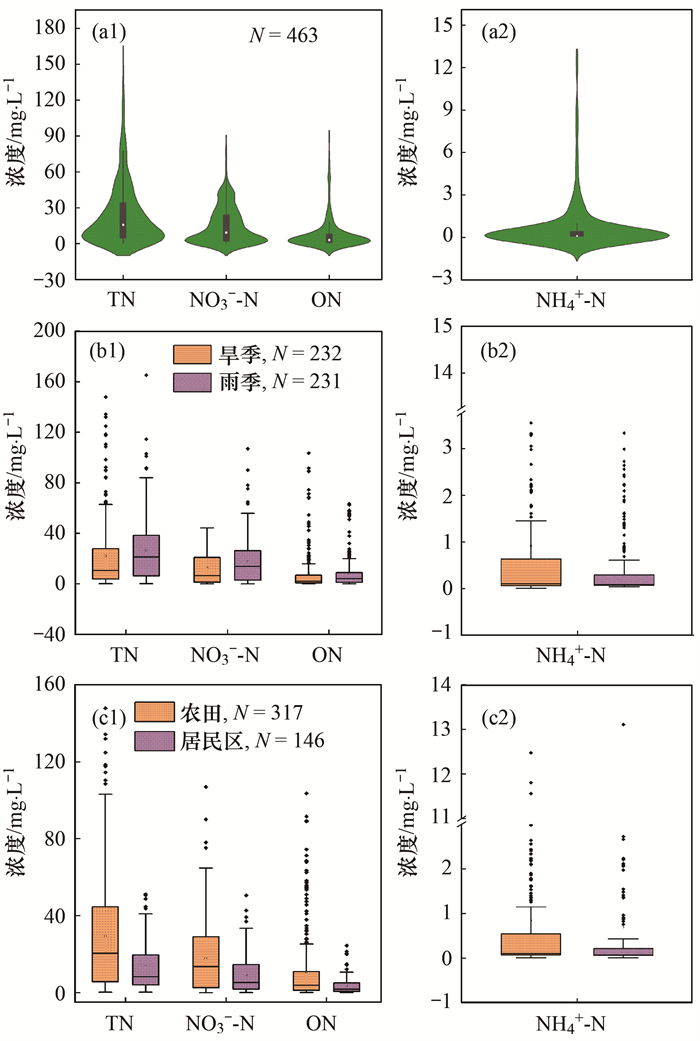
|
图 2 浅层地下水中各形态N浓度 Fig. 2 Concentration of various forms of N in shallow groundwater |
雨旱季交替改变了浅层地下水中各形态N浓度, 如图 2(b)所示.旱季浅层地下水中ρ(TN)、ρ(NO3--N)、ρ(ON)和ρ(NH4+-N)平均值分别为22.08、12.67、8.33和0.91 mg ·L-1, 近42%和26%的采样点ρ(NO3--N) 分别超过10 mg ·L-1和20 mg ·L-1.雨季浅层地下水中ρ(TN)、ρ(NO3--N)、ρ(ON)和ρ(NH4+-N)平均值分别为26.55、17.55、8.50和0.67mg ·L-1, 近56%和39%的采样点ρ(NO3--N)分别超过10 mg ·L-1和20 mg ·L-1.其中, 雨季和旱季的NO3--N存在显著性差异(P < 0.001), 且雨季TN、NO3--N和ON浓度均大于旱季(P>0.05), 而旱季NH4+-N浓度高于雨季(P>0.05).
农田和居民区的浅层地下水各形态N浓度差异也较大, 如图 2(c)所示.农田浅层地下水中ρ(TN)、ρ(NO3--N)、ρ(ON)和ρ(NH4+-N)平均值分别为29.38、17.90、10.64和0.84 mg ·L-1, 近57%和40%的采样点ρ(NO3--N)分别超过10 mg ·L-1和20 mg ·L-1.居民区浅层地下水中ρ(TN)、ρ(NO3--N)、ρ(ON)和ρ(NH4+-N)平均值为13.54、9.23、3.61和0.69 mg ·L-1, 近33%和17%的采样点ρ(NO3--N)分别超过10 mg ·L-1和20 mg ·L-1.除NH4+-N外(P>0.05), 农田浅层地下水中的各形态N浓度显著大于居民区(P < 0.001).
8个高原湖泊周围浅层地下水中TN、NO3--N、ON和NH4+-N浓度的平均值远大于中位数, 如表 2所示, 浅层地下水中TN、NO3--N、ON和NH4+-N变异系数范围分别为0.808~1.592、0.715~1.667、1.104~2.268和0.656~2.433, 属于中、高度变异强度[27], 变异性大, 变异系数差异大也能反映各形态N浓度在时空上分布的不均匀性.湖泊周围浅层地下水中ρ(TN)、ρ(NO3--N)和ρ(ON)平均值(mg ·L-1)较高的是杞麓湖(38.09、21.20、14.95)、滇池(35.18、24.09、10.36)和洱海(32.66、19.36、12.82), 中等的湖泊是异龙湖(16.73、7.74、7.77)、星云湖(19.25、13.02、4.89)和阳宗海(16.89、12.31、4.16), 较低的湖泊是程海(8.55、6.41、2.06)和抚仙湖(6.96、4.60、2.03).杞麓湖、滇池和洱海周围浅层地下水TN和NO3--N浓度显著高于抚仙湖和程海(P < 0.05), 其余湖泊间差异较小.杞麓湖周围浅层地下水ON浓度显著高于抚仙湖、程海和阳宗海(P < 0.05), 滇池和洱海、星云湖和异龙湖无显著差异. ρ(NH4+-N)平均值较高的湖泊是杞麓湖、星云湖和异龙湖, 分别为1.95、1.34和1.23 mg ·L-1; 中等浓度的湖泊是滇池、洱海和阳宗海, 分别为0.73、0.47和0.42 mg ·L-1; 浓度较低的湖泊是程海、抚仙湖, 分别为1.34 mg ·L-1和0.32 mg ·L-1.星云湖、异龙湖和杞麓湖周围浅层地下水NH4+-N浓度显著高于程海和抚仙湖(P < 0.05), 其余湖泊间差异较小.
|
|
表 2 高原湖泊浅层地下水各形态N浓度的变化特征/mg ·L-1 Table 2 Variation characteristics of N concentration in shallow groundwater of plateau lakes/mg ·L-1 |
8个湖泊周围浅层地下水中NO3--N空间分布呈现明显的区域异质性, 如图 3所示.滇池和阳宗海周围浅层地下水NO3--N污染主要分布在东、南部, 抚仙湖主要分布在北部, 洱海主要分布在西南部和东岸的挖色镇, 杞麓湖、星云湖、程海和异龙湖周围浅层地下水NO3--N污染分布较为均匀, 浅层地下水中高浓度的NO3--N分布区与水肥投入高的蔬菜和花卉等种植区吻合度高.对8个湖泊周围浅层地下水中ρ(NO3--N)超过20 mg ·L-1的样点统计发现, 8个湖泊周围浅层地下水的超标率从大到小依次为: 洱海(61%)、杞麓湖(48%)、滇池(45%)、星云湖(25%)、阳宗海(17%)、异龙湖(13%)、抚仙湖(6%)和程海(3%).可见, 洱海、杞麓湖和滇池周边浅层地下水受NO3--N污染较为严重, 这与种植的蔬菜等高施肥作物密切相关.
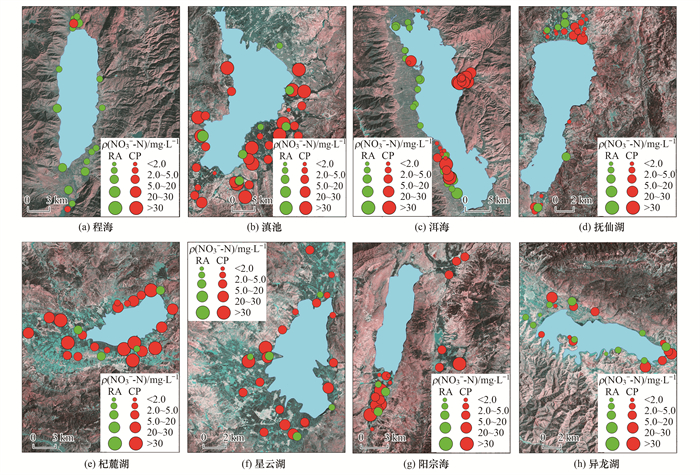
|
CP和RA分别表示农田和居民区 图 3 高原湖泊周围浅层地下水中NO3--N浓度空间分布 Fig. 3 Spatial distribution of NO3--N concentration in shallow groundwater around plateau lakes |
土地利用和季节变化不仅影响着地下水中各形态N浓度, 还影响着各形态N的组成比例.NO3--N是浅层地下水中主要的氮形态, 如图 4所示, NO3--N占TN的质量分数在雨季和旱季分别为66%和57%, 在农田和居民区分别为61%和68%.其次是ON, 其占TN的质量分数在雨季和旱季分别为31%和36%, 在农田和居民区分别为36%和27%.土地利用和季节变化对NH4+-N占TN的质量分数影响不大, 仅为3% ~5%.可见, 由于NO3--N强的移动性使得表层土壤中大量的NO3--N随降雨或灌溉经包气带进入浅层地下水, 并赋存于地下水中[28]. ON在高原湖泊周围浅层地下水中占TN的质量分数较高, 由于有机氮物理化学性质的多样性, 有机氮在氮循环中角色复杂, 进一步影响着地下水中NO3--N污染和氮的去除.
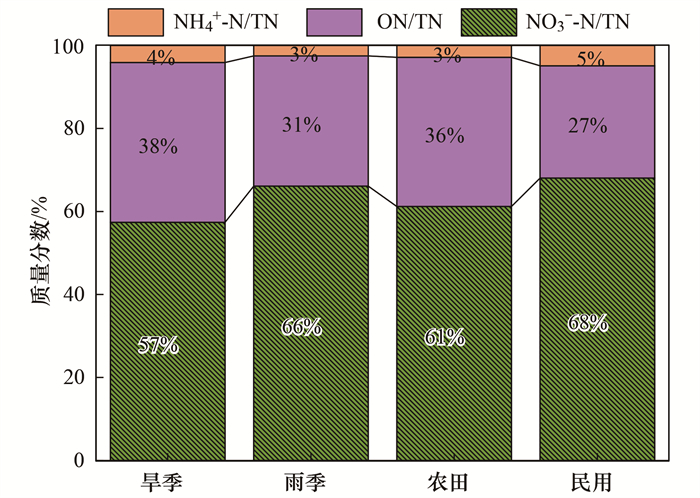
|
图 4 各形态N的组成 Fig. 4 Composition of various forms of N |
采用RDA分析了季节变化、土地利用对浅层地下水各形态N浓度的影响, 如图 5所示.季节变化引起地下水各形态N浓度与水环境因子排序结果前两轴解释量分别为83.23%和13.93%, 土地利用变化引起地下水中各形态N浓度与水环境因子排序结果前两轴解释率分别为85.28%和12.93%, 土地利用类型引起的水环境因子对浅层地下水中各形态N浓度变化较为明显, 浅层地下水中各形态N浓度很大程度下受土地利用变化的影响.雨季浅层地下水各形态N浓度集中在第一排序轴附近, 而旱季取样点比较分散[图 5(a)], 居民区浅层地下水各形态N浓度主要集中在第三象限, 而农田浅层地下水各形态N浓度在各象限均有分布[图 5(b)].浅层地下水中EC、DO、ORP和T是反映和影响浅层地下水中各形态N浓度的关键性因子, 而pH和SWL对浅层地下水各形态N浓度影响较小.

|
图 5 季节变化和土地利用下浅层地下水中各形态N浓度与影响因子的冗余分析 Fig. 5 Redundancy analysis of various forms of N concentration and influencing factors in shallow groundwater under seasonal variation and land use |
农田土壤剖面性质和氮素累积影响着浅层地下水中各形态N浓度, 对土壤因子与地下水中各形态N浓度的相关分析, 如图 6所示.浅层地下水中ONw、NO3--Nw和TNw间呈显著正相关(P < 0.01), 土壤剖面中NO3--Ns与pHs呈显著负相关(P < 0.01), 与土壤含水率(MWCs)呈显著正相关(P < 0.05).NH4+-Ns与OCs、MWCs与TNs和NH4+-Ns、土壤有机碳(OCs)和TNs与NH4+-Ns和OCs间呈显著正相关(P < 0.05), 可见, 土壤因子间和地下水各形态N间具有强烈的自相关性, 但土壤剖面与浅层地下水中各形态N浓度相关较弱, 可见, 土壤因子并不是影响浅层地下水各形态N浓度变化的关键因子.
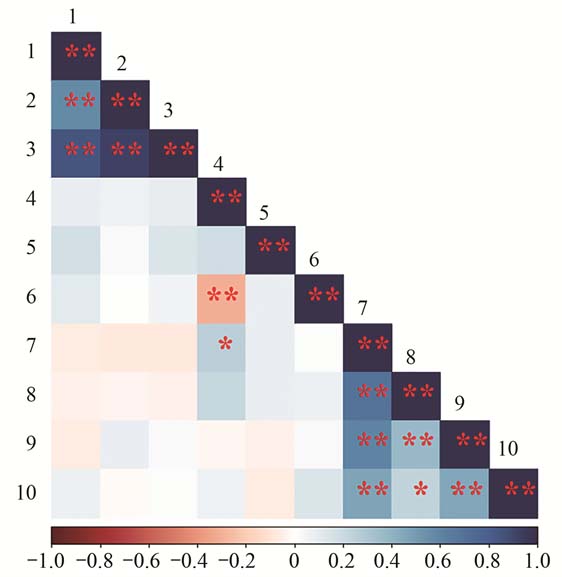
|
1.ONw, 2.NO3--Nw, 3.TNw, 4.NO3--Ns, 5.NH4+-Nw, 6.pHs, 7.MWCs, 8.TNs, 9.NH4+-Ns, 10.OCs, s和w分别代表土壤和浅层地下水, 土壤指标均为0~90 cm土层的平均值; *表示在0.05水平显著差异, **表示在0.01水平显著差异 图 6 土壤因子与各形态N浓度的相关性 Fig. 6 Correlation between soil factors and concentration of various forms of N |
季节变化和土地利用等外部因素引起了浅层地下水中各形态N浓度和组分的时空差异.雨季TN、NO3--N和ON浓度大于旱季, 而NH4+-N浓度则呈相反变化[12], 这主要是因为雨、旱季降雨量的差异, 影响着地下水位的波动, 水位上升缩短了地表氮素进入地下水中的距离, 也改变了土壤剖面-浅层地下水界面生化环境和氮循环过程, 造成了土壤剖面的氮素流失和浅层地下水各形态N浓度升高.旱季浅层地下水位较深, 由于硝化作用的限制, NH4+-N很容易在较深的地下水中积累[21], Chen等[29]的研究结果也表明了NH4+-N在更深的地下水中占主导地位.雨季NO3--N/TN大于旱季[30].NO3--N/TN和ON/TN在雨季差异大, 但旱季差异小, 这可能与水位下降[31]、农田施用有机肥和居民区畜禽养殖导致的NO3--N浓度下降有关.土地利用类型改变着表层水和氮负荷的投入, 一方面影响着肥料投入和植物残体向土壤的输入强度, 另一方面通过土壤水分管理和耕作方式等影响土壤养分的矿化、利用和流失, 造成土壤养分累积的空间异质性[32], 这些空间异质性变化最终影响到地下水各形态N浓度的空间差异.农田TN、NO3--N、ON和NH4+-N的平均值分别超居民区的53.91%、48.44%、66.07%和17.86%, 主要是由于高原湖泊流域农田施肥量高和复种指数大, 肥料投入总量较大, 农田区域氮素进入浅层地下水中负荷较高; 而居民区由于城镇和村落污水收集管网覆盖增加、地面硬化面积增大、农村生活垃圾的集中清运和畜禽养殖量的下降且粪污集中处理, 这些措施减少了居民区地表氮素流失负荷, 进而降低了居民区地下水氮质量浓度[33~35].农田浅层地下水中ON/TN的比例高于居民区, 这是由于农作物种植过程中大量施用有机肥有关, 而浅层地下水ON浓度高与地下水埋深浅、有机肥施用量大和土壤通透性强有关.NH4+-N/TN的比例居民区高于农田, 这可能与农村生活污水、畜禽养殖和垃圾渗滤液有关[29].氮素组成比表明, ON显著影响浅层地下水中NO3--N的变化[36].
影响浅层地下水中氮素空间差异的主要因素可分为两类, 一类是氮的来源决定着氮污染的发生位置, 另一类是氮素所处的周围环境决定着土壤和地下水中氮的迁移转化及其富集能力[37].滇池和阳宗海周围浅层地下水NO3--N污染主要分布在东部和南部, 洱海主要分布在西南部和东部挖色镇, 杞麓湖、星云湖和异龙湖周围地下水NO3--N污染分布较为均匀, 主要是由于这些区域农田面积较大, 蔬菜、花卉等高耗型作物大面积种植, 复种指数高, 导致盆地作物氮肥施用量高, 当大量氮肥被施入土壤后, 仅约35%的氮肥被作物所吸收, 大部分残留在土壤中, 由于NO3--N不易被土壤颗粒吸附, 易随水流下渗至含水层, 成为地下水中主要的氮污染物[38]. McLay[39]的研究也指出, 较严重的地下水NO3--N污染主要与化肥施用量较高的蔬菜种植有关, 蔬菜种植区的地下水NO3--N含量明显高于粮食作物种植区或城市区域.Zhang等[23]的研究表明土壤剖面结构的不同, 造成了洱海东(第四纪风化物发育的红壤)和西(河湖相沉积发育的水稻土)两岸同为蔬菜种植区浅层地下水NO3--N浓度的差异, 洱海东岸农田区域(26.39 mg ·L-1)浅层地下水NO3--N浓度平均值显著高于西岸的(9.01 mg ·L-1).抚仙湖周围浅层地下水NO3--N浓度低, 主要是因为湖泊周围农田从2017年开始休耕, 休耕3 a后才逐步恢复种植蚕豆、烤烟和水稻等低需肥作物, 对浅层地下水氮污染较小.程海周边由于地下水位深, 且取样点多农村饮水井, 所以浅层地下水中NO3--N浓度低.
3.2 浅层地下水水环境指标是影响氮素时空分布差异的主要驱动因素土地利用影响着地表氮负荷, 而季节变化通过驱动氮素迁移和改变地下水中的水文地球化学环境指标, 进而影响着氮的矿化、硝化、反硝化和厌氧氨氧化等转化过程, 最终反映在浅层地下水中各形态N浓度水平上.相关分析表明(图 5和6), 浅层地下水中的水环境指标是影响地下水各形态N浓度的主要因素, 而土壤剖面性质对地下水中各形态N浓度影响较小.根据RDA分析得出反映或影响云南高原湖泊周围浅层地下水各形态N浓度的关键因子是EC、DO、ORP和T.线性回归方程解释了这些关键环境因子与浅层地下水中NO3--N的关系(图 7), ORP(P < 0.05)、DO和EC(P < 0.01)与NO3--N成显著正相关.EC与NO3--N变化有较强的一致性.地下水中ORP和DO的增大, 会促使地下水处于氧化环境, 发生硝化反应, 使地下水中NO3--N的浓度升高[40], 相反, 当DO和ORP降到一定水平以下且有足够的有效碳源时, 会出现显著的反硝化作用, 导致浅层地下水中NO3--N的衰减[41].地下水温度T与NO3--N成显著负相关(P < 0.05), 随着温度的升高, 饱和土水界面的微生物活性增加, 土壤和地下水中的氮素转化增强, 从而影响地下水中的各形态N浓度, 研究区浅层地下水温度在15~25.5℃之间, 平均值为19.44℃, 在反硝化反应中, 温度通常为2~50℃, 一般假设反应速率每增加10℃, 反应速率就会翻一倍[42~45], 随着温度的升高或降低, 氮的反应速率将受到限制, 从而影响浅层地下水中各形态N浓度.

|
图 7 浅层地下水中NO3--N浓度与关键因子的线性关系 Fig. 7 Linear relationships between NO3--N and key factors in shallow groundwater |
(1) 云南8个高原湖泊周围浅层地下水中ρ(TN)、ρ(NO3--N)、ρ(ON)和ρ(NH4+-N)平均值分别为24.35、15.15、8.41和0.79 mg ·L-1, NO3--N是浅层地下水中主要的氮形态, 占TN的质量分数为57% ~68%, 其次是ON, 占TN的质量分数为27% ~38%. 8个湖泊463个采样点中有32%的采样点ρ(NO3--N)超过20 mg ·L-1, 其中, 洱海(61%)、杞麓湖(48%)和滇池(45%)的超标率最高, 其次是星云湖(25%)、阳宗海(17%)、异龙湖(13%), 最小为抚仙湖(6%)和程海(3%).
(2) 土地利用和季节变化影响着浅层地下水中各形态N浓度及其组成, 土地利用引起的浅层地下水各形态N浓度变化差异更显著, 地下水中的DO、EC、ORP和T显著反映或影响着浅层地下水中各形态N浓度的变化, 而土壤因子对浅层地下水中各形态N浓度影响较小.
(3) 为防止高原湖泊周围浅层地下水氮素污染进一步恶化, 应调整种植结构, 种植低耗高效作物; 合理施肥, 降低施肥强度, 提高氮肥利用效率; 禁止大水漫灌, 避开降雨施肥, 减少表层土壤氮素淋溶至地下水.
| [1] |
齐冉, 徐菲菲, 杨帆, 等. 木沥河流域氮素污染及其污染源解析[J]. 环境科学, 2020, 41(7): 3165-3174. Qi R, Xu F F, Yang F, et al. Analysis of nitrogen pollution and its pollution sources in the Muli River Basin[J]. Environmental Science, 2020, 41(7): 3165-3174. DOI:10.3969/j.issn.1000-6923.2020.07.044 |
| [2] |
王仕琴, 檀康达, 郑文波, 等. 白洋淀流域浅层地下水硝酸盐分布及来源的区域分异特征[J]. 中国生态农业学报(中英文), 2021, 29(1): 230-240. Wang S Q, Tan K D, Zhang W B, et al. Regional characteristics of nitrate sources and distributions in the shallow groundwater of the Lake Baiyangdian watershed[J]. Chinese Journal of Eco-Agriculture, 2021, 29(1): 230-240. |
| [3] |
王庆锁, 顾颖, 孙东宝. 巢湖流域地下水硝态氮含量空间分布和季节变化格局[J]. 生态学报, 2014, 34(15): 4372-4379. Wang Q S, Gu Y, Sun D B. Spatial and seasonal variations of nitrate-N concentration in groundwater within Chao Lake watershed[J]. Acta Ecologica Sinica, 2014, 34(15): 4372-4379. |
| [4] | Han D M, Currell M J, Cao G L. Deep challenges for China's war on water pollution[J]. Environmental Pollution, 2016, 218: 1222-1233. DOI:10.1016/j.envpol.2016.08.078 |
| [5] | Dich J, Järvinen R, Knekt P, et al. Dietary intakes of nitrate, nitrite and NDMA in the finnish mobile clinic health examination survey[J]. Food Additives & Contaminants, 1996, 13(5): 541-552. |
| [6] |
吴娟娟, 卞建民, 万罕立, 等. 松嫩平原地下水氮污染健康风险评估[J]. 中国环境科学, 2019, 39(8): 3493-3500. Wu J J, Bian J M, Wan H L, et al. Health risk assessment of groundwater nitrogen pollution in Songnen Plain[J]. China Environmental Science, 2019, 39(8): 3493-3500. DOI:10.3969/j.issn.1000-6923.2019.08.044 |
| [7] | Wu J J, Bian J M, Wan H L, et al. Health risk assessment of groundwater nitrogen pollution in Songnen Plain[J]. Ecotoxicology and Environmental Safety, 2021, 207. DOI:10.1016/j.ecoenv.2020.111245 |
| [8] | Manassaram D M, Backer L C, Messing R, et al. Nitrates in drinking water and methemoglobin levels in pregnancy: a longitudinal study[J]. Environmental Health, 2010, 9. DOI:10.1186/1476-069X-9-60 |
| [9] | Bryan N S, Alexander D D, Coughlin J R, et al. Ingested nitrate and nitrite and stomach cancer risk: an updated review[J]. Food and Chemical Toxicology, 2012, 50(10): 3646-3665. DOI:10.1016/j.fct.2012.07.062 |
| [10] | Stadler S, Talma A S, Tredoux G, et al. Identification of sources and infiltration regimes of nitrate in the semi-arid kalahari: regional differences and implications for groundwater management[J]. Water SA, 2012, 38(2): 213-224. |
| [11] | Schot P P, Pieber S M. Spatial and temporal variations in shallow wetland groundwater quality[J]. Journal of Hydrology, 2012, 422-423: 43-52. DOI:10.1016/j.jhydrol.2011.12.023 |
| [12] | Chen A Q, Lei B K, Hu W L, et al. Temporal-spatial variations and influencing factors of nitrogen in the shallow groundwater of the nearshore vegetable field of Erhai Lake, China[J]. Environmental Science and Pollution Research, 2018, 25(5): 4858-4870. DOI:10.1007/s11356-017-0791-7 |
| [13] | Cui R Y, Fu B, Mao K M, et al. Identification of the sources and fate of NO3--N in shallow groundwater around a plateau lake in southwest China using NO3- isotopes (δ15 N and δ18O) and a Bayesian model[J]. Journal of Environmental Management, 2020, 270. DOI:10.1016/j.jenvman.2020.110897 |
| [14] | He B N, He J T, Wang L, et al. Effect of hydrogeological conditions and surface loads on shallow groundwater nitrate pollution in the Shaying River Basin: Based on least squares surface fitting model[J]. Water Research, 2019, 163. DOI:10.1016/j.watres.2019.114880 |
| [15] |
耿玉栋, 张千千, 孙继朝, 等. 不同土地利用方式和地下水埋深对水中硝态氮浓度分布的影响[J]. 环境污染与防治, 2016, 38(6): 63-68. Geng Y D, Zhang Q Q, Sun J C, et al. Impact of land use types and groundwater depth on the distribution of nitrate nitrogen in groundwater[J]. Environmental Pollution & Control, 2016, 38(6): 63-68. |
| [16] | Benson V S, Vanleeuwen J A, Sanchez J, et al. Spatial analysis of land use impact on ground water nitrate concentrations[J]. Journal of Environmental Quality, 2006, 35(2): 421-432. DOI:10.2134/jeq2005.0115 |
| [17] | Lasagna M, De Luca D A, Franchino E. Nitrate contamination of groundwater in the western Po Plain (Italy): the effects of groundwater and surface water interactions[J]. Environmental Earth Sciences, 2016, 75(3). DOI:10.1007/s12665-015-5039-6 |
| [18] | Chen S F, Wu W L, Hu K L, et al. The effects of land use change and irrigation water resource on nitrate contamination in shallow groundwater at county scale[J]. Ecological Complexity, 2010, 7(2): 131-138. DOI:10.1016/j.ecocom.2010.03.003 |
| [19] | Guzman C D, Tilahun S A, Dagnew D C, et al. Spatio-temporal patterns of groundwater depths and soil nutrients in a small watershed in the Ethiopian highlands: topographic and land-use controls[J]. Journal of Hydrology, 2017, 555: 420-434. DOI:10.1016/j.jhydrol.2017.09.060 |
| [20] | Almasri M N, Kaluarachchi J J. Assessment and management of long-term nitrate pollution of ground water in agriculture-dominated watersheds[J]. Journal of Hydrology, 2004, 295(1-4): 225-245. DOI:10.1016/j.jhydrol.2004.03.013 |
| [21] | Zhao S, Zhou N Q, Liu X Q. Occurrence and controls on transport and transformation of nitrogen in riparian zones of Dongting Lake, China[J]. Environmental Science and Pollution Research, 2016, 23(7): 6483-6496. DOI:10.1007/s11356-015-5865-9 |
| [22] | Zhang D, Fan M P, Liu H B, et al. Effects of shallow groundwater table fluctuations on nitrogen in the groundwater and soil profile in the nearshore vegetable fields of Erhai Lake, southwest China[J]. Journal of Soils and Sediments, 2020, 20(1): 42-51. DOI:10.1007/s11368-019-02382-8 |
| [23] | Zhang D, Wang P L, Cui R Y, et al. Electrical conductivity and dissolved oxygen as predictors of nitrate concentrations in shallow groundwater in Erhai Lake region[J]. Science of the Total Environment, 2022, 802. DOI:10.1016/J.scitotenv.2021.149879 |
| [24] | Wang S Q, Zheng W B, Currell M, et al. Relationship between land-use and sources and fate of nitrate in groundwater in a typical recharge area of the North China Plain[J]. Science of the Total Environment, 2017, 609: 607-620. DOI:10.1016/j.scitotenv.2017.07.176 |
| [25] | Zhang M, Zhi Y Y, Shi J C, et al. Apportionment and uncertainty analysis of nitrate sources based on the dual isotope approach and a Bayesian isotope mixing model at the watershed scale[J]. Science of the Total Environment, 2018, 639: 1175-1187. DOI:10.1016/j.scitotenv.2018.05.239 |
| [26] |
王金林, 武广云, 刘友林, 等. 云南省化肥施用现状及减量增效的途径研究[J]. 中国农学通报, 2018, 34(3): 26-36. Wang J L, Wu G Y, Liu Y L, et al. The fertilizer application status and the approach of fertilizer-reduce and efficiency-increase in Yunnan province[J]. Chinese Agricultural Science Bulletin, 2018, 34(3): 26-36. |
| [27] | Liu X H, Xu X Z, Zhao J X. A new generalized p-value approach for testing equality of coefficients of variation in k normal populations[J]. Journal of Statistical Computation and Simulation, 2011, 81(9): 1121-1130. DOI:10.1080/00949651003724790 |
| [28] |
潘田, 张幼宽. 太湖流域长兴县浅层地下水氮污染特征及影响因素研究[J]. 水文地质工程地质, 2013, 40(4): 7-12. Pan T, Zhang Y K. A study of nitrogen pollution in shallow groundwater and its affecting factors in Changxing county in the Taihu Basin[J]. Hydrogeology & Engineering Geology, 2013, 40(4): 7-12. |
| [29] | Chen J, Qian H, Wu H. Nitrogen contamination in groundwater in an agricultural region along the new silk road, Northwest China: distribution and factors controlling its fate[J]. Environmental Science and Pollution Research, 2017, 24(15): 13154-13167. DOI:10.1007/s11356-017-8881-0 |
| [30] | Zhang X Y, Xu Z W, Sun X M, et al. Nitrate in shallow groundwater in typical agricultural and forest ecosystems in China, 2004-2010[J]. Journal of Environmental Sciences, 2013, 25(5): 1007-1014. DOI:10.1016/S1001-0742(12)60139-9 |
| [31] | Portela S I, Andriulo A E, Jobbágy E G, et al. Water and nitrate exchange between cultivated ecosystems and groundwater in the Rolling Pampas[J]. Agriculture, Ecosystems & Environment, 2009, 134(3-4): 277-286. |
| [32] |
白莹, 薛山, 鲁善海, 等. 沙颍河流域平原区土壤氮空间分布特征及影响因素研究[J]. 南京大学学报(自然科学), 2016, 52(1): 65-76. Bai Y, Xue S, Lu S H, et al. Study on spatial distribution characteristics of soil nitrogen and their influencing factors in Shaying River Basin[J]. Journal of Nanjing University (Natural Science), 2016, 52(1): 65-76. |
| [33] |
张婷, 陈世俭, 傅娇凤. 四湖地区地下水"三氮"含量及时空分布特征分析[J]. 长江流域资源与环境, 2014, 23(9): 1295-1300. Zhang T, Chen S J, Fu J F. Analysis of three-nitrogen concentration and spatial-temporal distribution of groundwater in Sihu Region[J]. Resources and Environment in the Yangtze Basin, 2014, 23(9): 1295-1300. DOI:10.11870/cjlyzyyhj201409016 |
| [34] | Gu B J, Ge Y, Chang S X, et al. Nitrate in groundwater of China: sources and driving forces[J]. Global Environmental Change, 2013, 23(5): 1112-1121. DOI:10.1016/j.gloenvcha.2013.05.004 |
| [35] | Wang Y J, Peng J F, Cao X F, et al. Isotopic and chemical evidence for nitrate sources and transformation processes in a plateau lake basin in Southwest China[J]. Science of the Total Environment, 2020, 711. DOI:10.1016/j.scitotenv.2019.134856 |
| [36] | Xin J, Liu Y, Chen F, et al. The missing nitrogen pieces: a critical review on the distribution, transformation, and budget of nitrogen in the vadose zone-groundwater system[J]. Water Research, 2019, 165. DOI:10.1016/j.watres.2019.114977 |
| [37] |
王佳音, 张世涛, 王明玉, 等. 滇池流域大河周边地下水氮污染的时空分布特征及影响因素分析[J]. 中国科学院研究生院学报, 2013, 30(3): 339-346. Wang J Y, Zhang S T, Wang M Y, et al. Temporal and spatial distribution of groundwater nitrogen pollution and influence factors in Dahe river catchment in Dianchi watershed[J]. Journal of Graduate University of Chinese Academy of Sciences, 2013, 30(3): 339-346. |
| [38] | Pastén-Zapata E, Ledesma-Ruiz R, Harter T, et al. Assessment of sources and fate of nitrate in shallow groundwater of an agricultural area by using a multi-tracer approach[J]. Science of the Total Environment, 2014, 470-471: 855-864. DOI:10.1016/j.scitotenv.2013.10.043 |
| [39] | McLay C D A, Dragten R, Sparling G, et al. Predicting groundwater nitrate concentrations in a region of mixed agricultural land use: a comparison of three approaches[J]. Environmental Pollution, 2001, 115(2): 191-204. DOI:10.1016/S0269-7491(01)00111-7 |
| [40] | Mayer P M, Groffman P M, Striz E A, et al. Nitrogen dynamics at the groundwater-surface water interface of a degraded urban stream[J]. Journal of Environmental Quality, 2010, 39(3): 810-823. DOI:10.2134/jeq2009.0012 |
| [41] | Rivett M O, Buss S R, Morgan P, et al. Nitrate attenuation in groundwater: a review of biogeochemical controlling processes[J]. Water Research, 2008, 42(16): 4215-4232. DOI:10.1016/j.watres.2008.07.020 |
| [42] | Sierra J. Nitrogen mineralization and nitrification in a tropical soil: effects of fluctuating temperature conditions[J]. Soil Biology and Biochemistry, 2002, 34(9): 1219-1226. DOI:10.1016/S0038-0717(02)00058-5 |
| [43] | Yoshikawa S, Takahashi H, Sasada Y, et al. Impact of land use on nitrogen concentration in groundwater and river water[J]. Soil Science and Plant Nutrition, 2015, 61(6): 898-909. DOI:10.1080/00380768.2015.1104521 |
| [44] | Olshansky Y, Knowles J F, Barron-Gafford G A, et al. Soil fluid biogeochemical response to climatic events[J]. Journal of Geophysical Research: Biogeosciences, 2019, 124(9): 2866-2882. DOI:10.1029/2019JG005216 |
| [45] | Yan D, Li J Q, Pei J M, et al. The temperature sensitivity of soil organic carbon decomposition is greater in subsoil than in topsoil during laboratory incubation[J]. Scientific Reports, 2017, 7(1). DOI:10.1038/s41598-017-05293-1 |
 2022, Vol. 43
2022, Vol. 43


